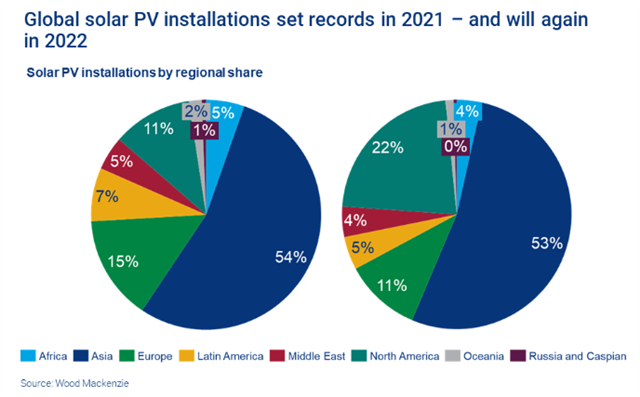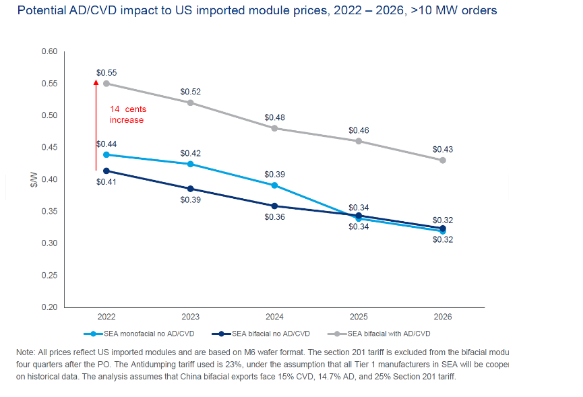The global solar industry continues to shine brightly, with global PV installations setting records in 2021 and will do again this year. And while supply chain challenges and elevated system pricing have created pressure for developers, manufacturing capacity expansion plans look set to provide some relief. However, the supply chain will have a close eye on evolving policy issues – including the anti-circumvention investigation in the US and India’s expanded incentives for domestic manufacturing.
Global solar PV installations will grow at an annual average of 8% from 2022 to 2031
We expect annual solar capacity to grow 25% this year and cumulative solar installations to surpass the 1,000 GWdc threshold. Asia leads the way – new solar capacity in China will reach 75 GWdc, contributing to an Asia-Pacific total of 110 GWdc in 2022.
Global solar PV installations set records in 2021 – and will again in 2022

Around the world, auctions continue to be a key driver for new installed capacity. However, while intentions around auctions have increased in the last year (particularly in Latin America) only major markets with a history of completed auctions have officially committed to schedules. New auction frameworks in Poland and the UK will, for example, accelerate utility-scale buildout in Europe.
Russia’s war with Ukraine will have ripple effects across the global solar market
While the unfolding humanitarian crisis is the central story, the Russia/Ukraine war is also having a real impact on the energy landscape. There’s little doubt that both Ukraine and Russia’s solar markets will suffer severely in 2022, and the ripple effect on the wider industry could alter our global forecast in the coming months.
The war has highlighted Europe’s reliance on Russian energy – which creates a silver lining for solar. A seismic shift is underway across the region to gain greater energy independence and energy security. The EU plans to significantly accelerate solar deployment, and renewable energy capacity generally, through the REPowerEU initiative. The bloc aims to deploy at least 420 GW of extra solar capacity by 2030 and 15 TWh of rooftop capacity this year.
Given its high dependence on Russian energy supplies – and the net zero ambitions of its new coalition government – Germany is expected to lead Europe’s solar deployment this decade.
Revamped manufacturing will bring relief to solar supply constraints in 2022
The Russia/Ukraine war will have an impact on the solar supply chain, felt through higher commodity prices. But the industry has been feeling the pressure of supply chain challenges for some time. In the US, for example, solar system prices are up across all segments due to elevated component prices and increased soft costs. Capital expenditure for a 100 MWdc utility-scale project is expected to increase by 6% in 2022.
Improvements in module technology and the adoption of large format modules could bring some relief. And significant manufacturing capacity expansion plans along the supply chain will further reduce the pressure. Nearly 200,000 MT of polysilicon, 1 GW of wafers, 1 GW of cells and 0.50 GW of modules are slated to come online by the end of 2022.
Capacity expansion plans will centre around China. However, manufacturing in other regions will also continue to grow as a complicated geopolitical landscape heightens the need for diversification in module supply.
Policy decisions made in Q1 2022 will affect the global solar supply chain
Two major policy events in Q1 will have significant implications for the solar industry:
1. Anticircumvention investigation in the US
In the US, Auxin Solar filed an anti-circumvention petition in February, to request a review of solar panel imports from Vietnam, Malaysia, Thailand and Cambodia. Auxin alleges that Chinese producers are circumventing antidumping and countervailing duties (AD/CVD) by carrying out most of the manufacturing of solar components in China, then completing them in Southeast Asia. In March, the US government agreed to investigate – depending on the outcome, solar module imports from these four countries may become subject to an AD/CVD.
US module imports from Southeast Asia subjected to proposed AD/CVD will not be competitive

The decision to investigate has had an immediate impact. A substantial amount of module volumes for utility-scale projects has been postponed, and we’re seeing module manufacturers pushing the responsibility of ‘importer of record’ – and therefore the risk – to the buyer. To sustain project deployments and viable profits, developers may well search for manufacturers that can manoeuvre their supply chain to avoid new tariffs.
2. Boost to domestic manufacturing in India
In February, the Indian government expanded the budget for its Production Linked Incentive (PLI) scheme for domestic manufacturing. From April, all solar imports in India will be subject to a Basics Custom Duty of 25% and 40% for cells and modules, respectively.
An increased budget to the PLI scheme is intended to support 40 GW of additional manufacturing capacity, and gives further incentive to develop upstream manufacturing of polysilicon, wafers, and cells.
These are significant policy decisions that will shift the pricing and supply dynamics in the US and India – and impact the global supply chain.


